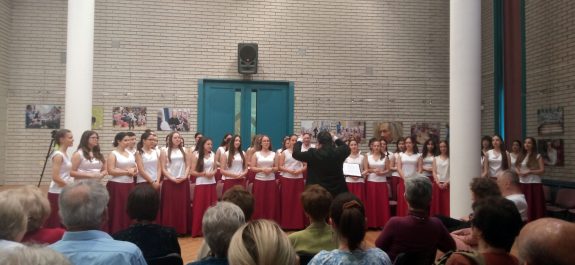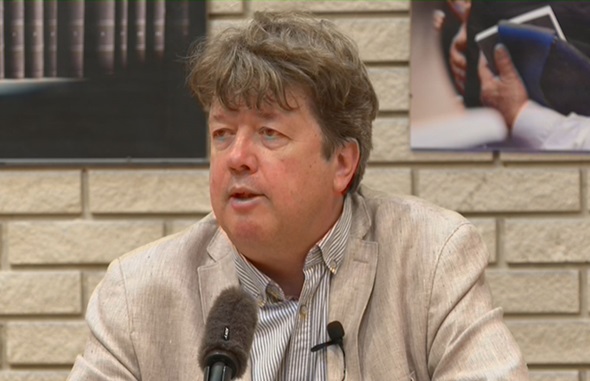 Hungary Choral works by Péter Tóth: József Katona Central Library, Kecskemét, Hungary, 12.4.2024. (AK)
Hungary Choral works by Péter Tóth: József Katona Central Library, Kecskemét, Hungary, 12.4.2024. (AK)

Although his compositions are performed throughout the world and he won several important prizes throughout the decades, Hungarian composer Péter Tóth’s name is not yet well known by the public outside Hungary. Furthermore, it is likely that, apart from professional and amateur music practitioners, the public is not as aware of Tóth’s accomplishments as should be in Hungary either.
Here is a man with a significant compositional output, a serious dedication to arts and knowledge and, finally, without particular interest in self-promotion. Now 59 years of age and Dean of the School of Music at the University of Szeged, in his youth Tóth studied percussion and composition, graduating in the latter at the Franz Liszt Academy of Music (Budapest) in 1990. Tóth’s compositions embrace instrumental, orchestral and vocal works; he has also composed music for film and theatre productions. Significantly, many of his choral pieces have won national and international awards. Featuring some of his choral compositions, Tóth presented a talk combined with audio examples as well as with a live concert in Kecskemét.
Approximately 85 kilometres from Budapest, Kecskemét is the birthplace of Zoltán Kodály. Although he was still a young child when his family moved from Kecskemét, the town remained important for Kodály all his life. The first Kodály music primary school in Hungary was established in Kecskemét (1950) and the town still hosts the by now expanded school (primary and secondary) as well as the Kodály Institute which seems to be focusing on catering for foreign students.

At this Tóth presentation I witnessed Kodály’s long-lasting positive influence in audio examples performed by the Kölcsey Choir (Debrecen, with conductor László Tamási), Cantemus mixed choir (Nyíregyháza, with conductor Soma Szabó), and Cantemus women choir (Nyíregyháza, with conductor Dénes Szabó). Furthermore, I also witnessed live performances by the Aurin Girls Choir (with conductor Lászlo Durányik) whose members attend the Kodály music secondary school of Kecskemét.
With his 113 choral works, choral music is an important thread throughout Tóth’s compositional journey. As early as in 1984 – at the age of 19, before entering the Franz Liszt Academy – Tóth composed his Kis szvit (Little Suite for children choir) which eight years later won third prize at a prestigious composition competition (1992). Over the following years/decades Tóth was awarded with many important prizes.
The twelve Tóth choral compositions presented at my Kecskemét outing showed a deep respect towards the Kodály tradition by taking high quality poetic texts or folk texts as their basis. Three were composed to poems by Sándor Weöres: Kis híd, deszka híd, 1984; Holdének, 1993; Stabat mater, 1996. Kodály too used poems by Weöres: he commissioned Weöres to write fifty short poems for little people and thus produced his charming fifty nursery songs. Two of the Tóth choruses presented were composed to texts by Jenő Dsida (Lángok, 2005) and Anna Mechler (Üres a ház, 2016) respectively. From what I could observe on one hearing, melody and rhythm are in perfect harmony with the texts.
Tóth’s choral pieces on folk text do not become folk song initiations; while respecting the texts, the musical realisations belong to high quality and highly enjoyable art music: Magas hegyről foly’ le a víz, 2000; Átok dal, 2001. Since 2004 Tóth often composes to Latin texts. Not knowing any Latin, I just sat back and enjoyed the beauty: Ave Maris stella, 2004; Ave Maria, 2011; Ubi caritas et amor, 2012; Et incarnatus est, 2019; Carpe diem, 2022.
All twelve Tóth choruses presented in Kecskemét are richly polyphonic, mostly in three parts for children/girls/women voices although Et incarnatus est is for an eight-part mixed choir. Tóth uses numerous technical devices, including long held notes that is as if a pedal is pressed on some part of the choir (Átok dal / Curse, 2001). Elsewhere vocal glissando can help to increase the required expression (Lángok / Flames, 2005 – originally for male choir but several versions exist). Depending on the chorus Tóth writes for, technical challenges can be included (such as the high B note which is a third above the normal soprano range) but, crucially, Tóth choral pieces are enjoyable to perform as well as to listen to.
The Aurin Girls Choir under their conductor László Durányik delivered impressive live performances of Ave Maria (2011), Ubi caritas et amor (2012) and Üres a ház (2016). They sang from memory; they sang with musicality and they sang in tune. Singing in tune without any accompaniment, especially in three-part compositions, should not be taken for granted. Here we had forty-five teenagers between ages 15 and 19, fully focused not only on their own performances but also on Péter Tóth’s talk. Chorus membership is voluntary, but all the girls are students at the Kodály music secondary school in Kecskemét. This school is combined with the Kodály music primary school: music teaching with Kodály’s philosophy compliments regular school subjects.
Mostly so-called Kodály classes have little or nothing to do with Kodály’s philosophy. Sadly, misconceptions are often pushed forward even by Hungarians (as I keep seeing it in London and elsewhere). However, judging by the behaviour/performances of the Aurin Girls Choir, Kodály is a way of life in the Kecskemét music primary and music secondary school.
I am certain that Zoltán Kodály would have been happy with Péter Tóth’s talk, his compositions and the performances. I am glad I made the trip to Kecskemét.
Agnes Kory
